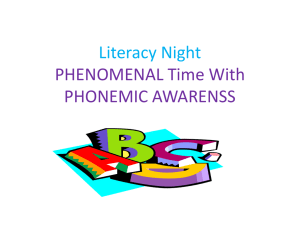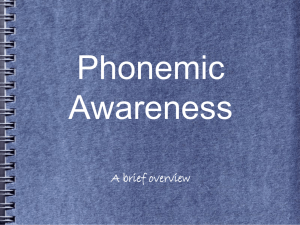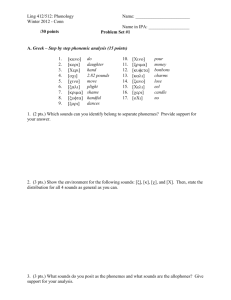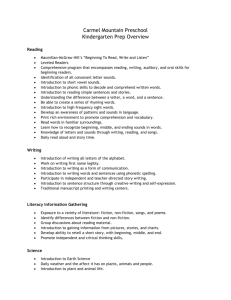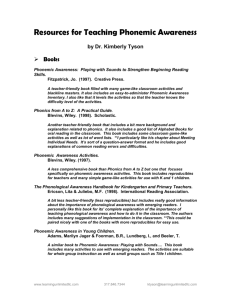six components of early literacy
advertisement
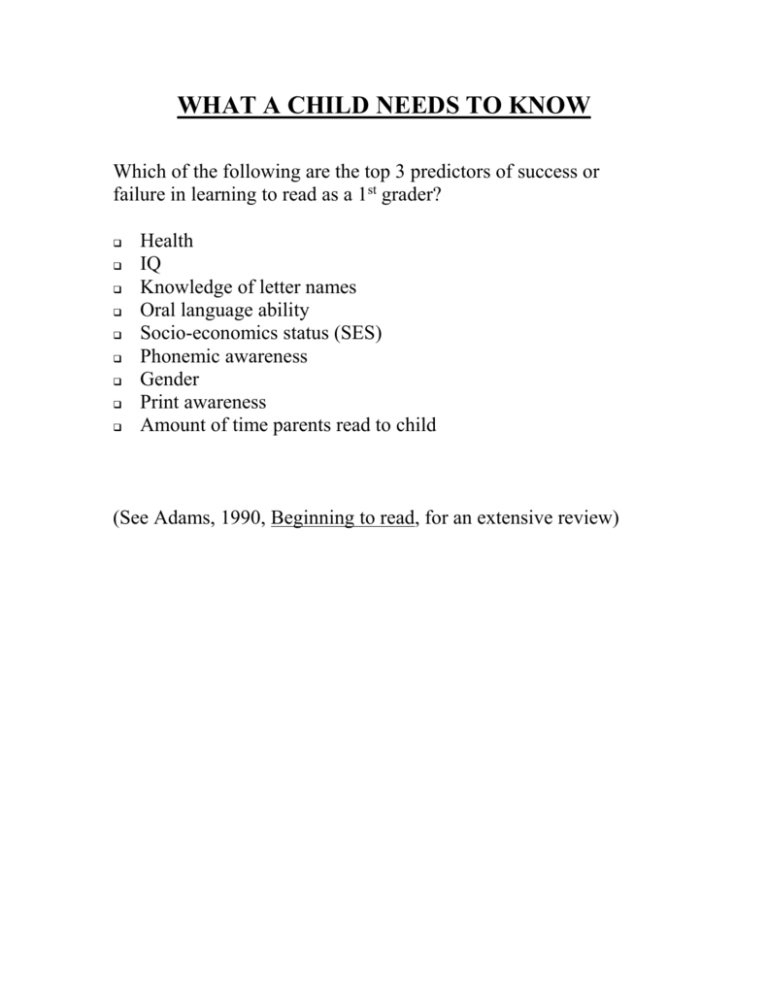
WHAT A CHILD NEEDS TO KNOW Which of the following are the top 3 predictors of success or failure in learning to read as a 1st grader? Health IQ Knowledge of letter names Oral language ability Socio-economics status (SES) Phonemic awareness Gender Print awareness Amount of time parents read to child (See Adams, 1990, Beginning to read, for an extensive review) SIX COMPONENTS OF EARLY LITERACY Phonemic Awareness Ability to hear sounds in our spoken language Categorizes words according to onset and rime (cat/hat; pen/pig) Recognizes beginning sounds Letter/Sound Knowledge Identifies, names, and writes all upper and lower case letters Matches sounds with letters orally and in writing Begins to develop ability to blend C-V-C words Uses invented spelling when free writing Print Awareness/Appreciation Understands print has meaning Understands concepts of letter, word, sentence, page, directionality, etc. Listens to, eventually reads, and appreciates different types of text (e.g., different genre’s of fiction, non-fiction, poetry) Listening Comprehension Use prior knowledge to construct understanding while listening/reading Responds to text at multiple levels (factual, inferential, applicative) Writing Express self by drawing and writing letters and words. Responds to text by drawing and writing words and letters. Is making progress toward forming letters correctly. Oral Language Communicates ideas through speech with age appropriate vocabulary, syntax, and function. Is expanding knowledge of word meanings used in all types of text (synonyms, antonyms, etc.) Sources: Beginning to Read by Marilyn J. Adams, 1990 Starting Out Right by National Research Council, 1998 KEY POINTS FROM “PHONEMIC AWARENESS AND YOUNG CHILDREN” BY BARBARA A. WASIK (Childhood Education Journal, Spring 2001) Phonemic awareness is the ability to auditory recognizes and manipulate sounds in words. Phonemic awareness is not the mastery of sounds in words, but the awareness of sounds in words While not aware of names of different sounds, children can create words (even words that are not real) that sound the same. Phonemic awareness is not the same as phonics. A background in phonemic awareness is critical, regardless of the method of teaching reading. What research says about phonemic awareness. A relationship exists between phonemic awareness and subsequent reading success in 1st and 2nd grades. Children as young as 3 and 4 demonstrate phonemic awareness. Opportunities to play with language develop phonemic awareness. Adults can create opportunities for children to learn phonemic awareness. The Development of Phonemic Awareness Children begin to attend to sound in words. If given experience in language, children can recognize words that rhyme and those that have the same beginning sounds. Children can begin to discriminate among words with similar beginning and ending sounds (not in isolation). Children can identify sound chunks (syllables) in words (kindergarten). Children can then focus on individual phonemes (sounds) within the sound chunks. Children begin to hear the three distinct sounds in the word “bat,” which are /b/, /a/, /t/. Creating a Classroom environment that supports young children’s phonemic awareness. Avoid creating an environment in which children are drilled in phonemic awareness, especially if the associated activities are separate from regular classroom activities. Storybook reading o Provides an opportunity for children to hear sounds in words within the context of a connected text. o Books with rhyming words appeal to young children and can facilitate phonemic awareness development. o Rhyming books should have words that are easy to hear. Rhyming words should be in close proximity to one another (example: Dr. Seuss’s One Fish, Two Fish; Hop on Pop NOT The cat in the Hat). o Books with alliteration provide opportunities for children to hear words that have the same beginning sound (example: Three Billy Goats Gruff with “Trip, trap, trip trap”). o Alphabet books introduce children to beginning sounds in words. Simple vocabulary and themes that children can understand. o Introduce children to a new vocabulary. o Books with rhyming and alliteration provide teachers with an opportunity to engage children in story extension activities that promote thinking about sounds and words. Nursery rhymes, jingles, poems, and finger play activities o Allows a child to hear the rhythm of language. o Points out words that sound alike. o Choose rhymes that actually rhyme. o Choose rhyming words that are close in proximity, particularly every line instead of every other line. o Having children create their own rhymes and jingles (a good beginning is a child’s name). Circle Time Activities o Having children rhyme words that are associated with the calendar, weather, daily schedule, etc. o Make connections with classroom themes and activities. o Conduct these activities orally rather than using visual presentation (example: hare and pair rhyme but do not look alike visually). Writing o Provide opportunities to explore writing. o Children make connection between written and spoken words. o Invented spelling gives them an opportunity to explore sounds and letters. o Have children write names in artwork. Beginning with what is familiar to children/make connections across the curriculum. Teachers of young children can facilitate the reading readiness process in a developmentally appropriate way by providing opportunities for children to comprehend the relationship between sounds and words, as opposed to presenting concepts in isolation. Children need to learn phonemic awareness by engaging in fun and motivating activities that promote the recognition and manipulation of sounds in words. Knowing the name of the letters of the alphabet is the best predictor of beginning reading achievement! * It is not simply accuracy that gives a child an advantage in learning to read, it is also the ease or fluency with which she can do so. * Comfortable knowledge of the letter names hastens the learning of letter sounds because it mediates the ability to remember the sounds. * Automaticity of recognizing letters helps the child see the letter as a ‘whole.’ This same skill will assist him in seeing words as specific patterns of letters. * * Beginning to Read: Thinking and Learning about Print, Marilyn Adams. 1990. (45) Developmentally Appropriate Activities for Teaching the Alphabet 1. Have a large alphabet display at eye level! 2. Use alphabet songs and chants 3. Begin to use the terms: letter, alphabet, and word. 4. Draw attention to letters and model word writing in front of the children. 5. Identify the uses of letters (i.e., books, newspapers, magazines, signs, labels, etc.) 6. Make alphabet activities fun! Learn to Read and Write: Developmentally Appropriate Practices, NAEYC/IRA Joint Position Statement, 2000. Children’s Literature Genres Non-fiction - Factual information of biographical (example: “All About Whales”). Traditional Literature – Passed down from oral traditions, such as: fairytale, folktales, legends, etc. (example: “The Three Pigs”). Modern Fantasy – Fantasy stories, usually set in modern times, with a known author (example: “Harry Potter”). Contemporary Realistic Fiction – Realistic fiction that has no fantasy elements (example: “Everything on a Waffle”). Historical Fiction – Fiction with a historical setting and characters (example: “The Oxcart Man”). Multicultural Fiction – Any fiction where the characters are different in background, ethnicity, lifestyle, religion, gender or ability than the reader (example: “Amazing Grace”). Poetry – Poems that span all of the genres above (example: “The New Kid on the Block”). Use opportunities to inspire classroom discussions-both in a one-to-one and a whole-class format. Affirm children in their efforts to express themselves, but also gently nudge them to be more precise in their vocabulary and syntax. Enhance their syntactic abilities beyond the usual “and then, and then, and then,” by asking questions that encourage them to sue words like “because,” “after,” “since,” and “while” in their responses. If a child says, “I ate a read lollipop,” you might help him or her be more precise by saying, “But there could be two different red lollipops. Did you have strawberry or cherry?” 1. Choose books and stories to read aloud that are about many different creatures, places, and things. Augment each selection with pictures, discussion, and especially other books and stories that allow the children to revisit and extend their new knowledge. 2. Sociodramatic play activities give children a chance to develop language and literacy skills, a deeper understanding of narrative, and their own personal responses to stories. Encourage children to retell, reenact, or dramatize stories or parts of stories they have read. 3. Have children ask their questions about the story and respond to classmates’ questions. 4. Encourage them to follow the text with movement, mime, or choral reading (repetitive books). 5. Draw children’s attention to the forms of print, such as punctuation, letters, the space around words, chapter title placements, the line length differences between prose and poetry. 6. Provide repeated reading of the same story so children can gain mastery of the narrative, ideas, and language. Reading Aloud with Children 1. Ask questions beforehand. 2. Read the story with engaging interest. 3. Ask questions?? 4. Point out interesting facts. 5. Don’t hesitate to reread a story. 6. Encourage your child to retell the story. LITERACY CENTERS Sand Table: There are many literacy activities that can be done in the sand table. Sand is an excellent medium for beginning writing skills. Children should be forming letters with sand before they are asked to master paper and pencil writing. Children can write their name (or letters) with their fingers in a thin layer of sand (a layer of sand on a shallow tray or lid). This makes it possible for the child to “feel” the letters they are writing, as well as giving them an opportunity to “adjust” or “fix” letters with greater ease than paper provides. Another excellent development activity is to use wet sand and have the students mold the letter shapes. This is a wonderful physical activity for cognitive memory development. Sand can also provide an opportunity for children to work on comprehension. The students can make sand responds to stories read to them. The children can replicate their favorite part of the story or answer a number of questions the teacher might pose. Creating sand sculptures is an excellent alternative to having the child draw a picture. Language Center: There are many excellent hands-on and independent activities that can take place in a language/reading center. 1. Extension activities with nursery rhymes for phonemic awareness. (Creating pictures, etc., out of paper or magazine pictures to create a project about the nursery rhyme they are learning.) 2. Extension activities for other literature read in class. 3. Activities where the students are asked to manipulate certain letters of the alphabet (for example: finding that letter in the newspaper and cutting it out, creating patterns with several letters they already know, making a small journal of things in the classroom that begin with that letter, etc.). 4. Their journal could be part of this center when they are being asked to respond to some text used in class. Responding to text is a vital part of reading and listening comprehension. 5. Have children illustrate a large picture book written as a group by the class. 6. Provide sequencing activities with pictures from stories or activity songs that you have used with the class (example: I Know and Old Woman Who Swallowed a Fly). Writing Center: There are many pre-writing and writing activities that can be appropriate for young children at the writing center: 1. Journal writing. These activities should be illustrations only until the child is comfortable and has enough skills to begin attaching letters/words to his/her responses. REMEMBER! The main reason for having journals is to get the children to respond and put their thoughts on paper! Be careful not to always get dictation from the child or “correct” their response. Although this may be appropriate on occasion, we want the students to feel comfortable that they can respond and put their thoughts on paper without having an adult always correct their work. 2. Magnetic letters. A child should always manipulate letters before being required to write them. This is particularly true for their name. They should be able to recognize the letters of their name and have physical “hands-on” experience with them before they begin writing it on paper. 3. Letter writing. When the child is ready, the writing center provides the perfect setting for a child to practice writing letters and eventually words. Doing this in a center provides the child with the opportunity to take the time necessary to begin that process. Never send a child by himself to the writing center, for a letter writing assignment, if he cannot independently form the letters. Provide a helper for any one who needs help. Centers should never be frustrating. 4. Sand writing. Mentioned earlier in the sand table section, child love to write letters and words in sand. Library Center: There should always be a library center in the classroom. It is very important that children are allowed to get their hands on books. 1. Provide a literature library of different kinds of text for students to look at. For example, there are picture books available in every type of genre of children’s literature (non-fiction, modern fantasy, realistic fiction, historical fiction, multicultural fiction, poetry, etc.). 2. It is good practice to have all the books that are read to the class available for the students to look at and retell the story. For special books, the teacher may need to have a monitoring system (checking it out from the teachers, etc.). It is critical, however, that children are able to examine stories that they have been listening to and discussing. This is an important comprehension tool. 3. Writing stories, as a class, is an opportunity to help your students be “authors.” Those books should be available in the class library center for the children to retell and examine, as well as look at their contribution to the publication.



